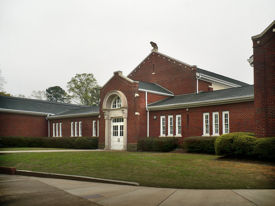Shades Cahaba Elementary School
Shades Cahaba Elementary School, located at 3001 Independence Drive on the intersection with Hollywood Boulevard, is one of three elementary schools in Homewood City Schools serving grades kindergarten through fifth. It was built as Shades Cahaba High School in 1920 and became an elementary school in 1949. It primarily serves households in the eastern portion of Homewood, including the neighborhoods of Hollywood and Rosedale. The school mascot is an owl and the school colors are dark green and white. Enrollment in 2005 was approximately 500 students. The principal is Sue Grogan.
History
Shades Cahaba High School
Around 1916, Will Franke and William Acton led a successful campaign convincing the Jefferson County Board of Education that a high school was needed south of Birmingham. With the board's permission, the Shades Valley School District was formed and the residents passed a three-mill tax in 1916 to build a new high school. County school officials selected ten acres costing $3,000 at the intersection of Montgomery Highway and the juncture of Oxmoor and Old Montevallo Roads as the site for the school. Construction of the three-wing, brick building began in 1919 and cost $52,000.
School officials sponsored a naming contest for the school. Although the submitter's name has been lost, the winning entry was Shades Cahaba High School. The school, Jefferson County's first consolidated high school, opened to 156 students on September 19, 1920 with four grades and five teachers. As the new high school opened, elementary school students from nearby Union Hill Methodist Episcopal School moved into a wooden, two-room building on the high school's property, just east of it. By the late 1920s, both schools were called Shades Cahaba.
The school's first principal, James M. Ward, oversaw the school's growth for its first 23 years. He was assisted by the Shades Cahaba School Improvement Association, which formed in October 1920 and later became the school's Parent-Teacher Association (PTA). Electricity was not run to the school until its second year. In 1922, an unfinished, unpainted, wood-frame building was built behind the school to serve as both lunchroom and wood shop. The first class graduated in 1923. The first addition, to help relieve overcrowding, was made in the summer of 1926 and a second, including a new lunchroom, was made in the summer of 1927. The additions also allowed the 3rd through 6th grade students to be moved to the main building. In 1928, the two schools were placed under the same administration, although it was grades 7th through 12th that were considered the high school. By 1932, the school had expanded to 22 teachers, plus an associate principal.
Shades Cahaba had an active sports program featuring boys' and girls' basketball teams and boys' football and baseball teams, all known as the Mountaineers, or "Mounties" for short. Shades Cahaba was the first Alabama high school to have an athletic field featuring lighting, speakers, and an electronic scoreboard. The yearbook was the Shades-Cahaba Owl and the school newspaper, known as "The Owlet," was published as part of the Shades Valley Times. The yearbook and newspaper were both named for a 900-pound, cast-concrete owl perched atop the middle gable of the building, above the northern entrance facing Hollywood Boulevard.
In 1936, because of the Great Depression, Jefferson County Schools decided to close their schools early. Homewood provided funds to keep Shades Cahaba, Edgewood Elementary, and Rosedale Schools open nine months a year. Shades Cahaba was the only high school in Alabama to keep its Southern Association of Colleges and Secondary Schools accreditation throughout the Depression.
After the neglect of the Depression, the school was completely repaired and repainted in the 1940s. A central heating system and fluorescent lights were also installed. Funds for the overhaul came from both the county and Homewood with additional assistance from local civic groups. While improvements were made to the existing facility, the student population topped 1,000 by the mid-forties and the citizens of Homewood began demanding a new school to handle the overcrowding. The county school board, with the promise of financial assistance from Homewood and newly incorporated Mountain Brook, finally agreed. However, they declared the name of the new school would be Shades Valley High School. Many students and graduates of Shades Cahaba objected to not carrying the name of the existing school to the new one. The Homewood City Council and several civic groups also passed resolutions requesting the name be continued, but the county refused. Shades Valley did, however, continue the team name of the Mountaineers when it opened in 1949. At that point, Shades Cahaba became strictly and elementary school.
Shades Cahaba Elementary School
With the school's conversion, the concrete owl was removed in 1949 for unknown reasons. After spending several years in county storage, it was sold to a private party and wound up in a vacant lot. After its rediscovery, it was eventually restored to its original perch in the late 1970s.
Shortly after the school's conversion, the county and city both provided a total of $67,000 for a new auditorium and gymnasium. In the early 1950s, a pedestrian tunnel underneath Independence Drive was built to allow students access to the school from the west without having to cross multiple lanes of traffic. This tunnel was used to film one of the scenes of the 1988 film, The Verne Miller Story.
In the 1960s, Shades Cahaba was the only public school in the area offering special education classes. Another building renovation in the early 1990's moved the main entrance from the side facing Hollywood Boulevard to what had been a back corner, facing southwest to Independence Drive at about a 45 degree angle.
Principals
Shades Cahaba High School
Shades Cahaba Elementary School
- Lelton Cobb
- Louis LeVaughn, 1970–1981
- Mike Miller, 1981–?
- Sue Grogan, ?–present
Accomplishments
- United States Department of Education "Blue Ribbon School"; 1993-94.
References
- Summe, Sheryl Spradling. (2001). Homewood: The Life of a City. Homewood, AL: Friends of the Homewood Public Library.
